|
Horses!
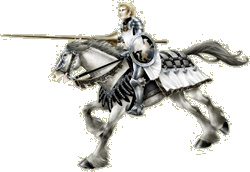 |
|
Get your free
wallpaper featuring art by Simutronics artist Tracy
Butler!
|
|
|
|
|
Saddle Up For Adventure!
The almost unbearable period of waiting is finally over. Horses
have arrived and they're packed full of brilliant features and nearly
countless varieties.
Here are some of the things to look for in the expansive new Horse
System.
Stables and Corrals
The stable is the center of the horse world. That is where you
can buy an animal, tack and food for your mount, sell your horse
if desired, stable or locate your animal, receive training, as well
as play with your mount. Visit a corral to pick out your new horse
(or pony for Halflings and Gnomes) and ride home in style! Leave
your horse at a stable, and he will be groomed and fed as needed.
Buying
At the stable, you can either LOOK IN CORRAL or simply
ORDER to see a menu of the currently available horse and
their price. To LOOK at a specific horse, you must use
the number in this listing. For example, if you want to look at
the third horse in the corral, you need to LOOK 3. Likewise,
to purchase the third horse in the corral, you would ORDER 3.
Ponies are only rideable by short (Halfling, Dwarf and Gnome)
races. Horses can be trained to KNEEL to allow these races
to mount.
Colors and Markings
| Some (But Not All!)
Possible Coat Colors |
- Bay (Variants include: bay (just plain bay), cherry, dark,
and medium)
- Black
- Buckskin
- Chestnut (Variants include: medium, light, red, liver)
- Dun (Variants include: flea-bitten, plain, red)
- Grey (Variants include: dappled, dark, light, rose, silver,
smoky, steel)
- Gold-colored
- Roan (Variants include: blue, red)
- White
|
Special notes: "Flea-bitten" does not mean the horse
has, or even HAD fleas. This is merely a colorization pattern that
is actually quite beautiful. Also, "red" and "blue"
roan horses aren't really "red" or "blue", they're
more of a grayish tone with hints of brown and black, respectively.
Height
Horse height is measured in hands (abbreviated hh), which are 4"
each. Note that this is the height from the ground to the top of
its shoulder, not to the tip of the ears. Ponies can range from
8 to 13 hands, while horses generally range from 12 to 18 hands.
There are rumors of even taller horses being available in rare instances!
|
|
|
This chart illustrates the size relationships
of ponies, small horses and large draft animals when
compared to a Human male.
|
For a slighty
larger (700 x 353) version of this image by Simutronics
artist Tracy Butler, simply click here.
For a much larger version (1000 x 505), click here.
|
|
Detailed Appearances
Horses also have a number of individual features. Coat variations,
mane color, tail color, and various marks that may appear on the
head, legs or elsewhere.
(Please note that these lists do not include ALL the possibilities,
as some colors and markings are especially rare and the current
system allows for dozens of additional markings and colors to be
potentially added later.)
| Examples of Possible Coat
Variations |
- a medium reddish brown colored coat and light brown highlights
- a light reddish brown colored coat and mahogany highlights
- a dark red colored coat and light brown highlights
- a dark grey coat that has a combination of light and dark
highlights
- a medium dark grey coat and white highlights
- a light grey coat mottled with darker spots on the hindquarters
- a greyish brown coat speckled with black spots over the
entire body
- a black coat that has white hairs interspersed throughout
- a reddish brown coat that has white hairs interspersed
throughout
- a bright reddish brown coat and red highlights
- a dark reddish brown coat and dark red highlights
- a glistening white coat
|
| Examples of
Mane and Tail Colors |
| black |
white |
grey |
flaxen |
brown |
| Examples of Horse Markings |
- a white star-shaped mark on the forehead
- a broad, vertical white marking extending the length of
the face
- white marks on the legs extending from the top of the
hoofs to the top of the ankles
- a white mark extending from the top of the hoof to mid-foreleg
on all four legs
- dark splotches on both flanks and white legs below the
knees
- a wide white stripe running down the center of the face
- a wide white stripe running from below the left eye to
just above the nostrils
- a white star-shaped mark off to the right of the forehead
- a white star-shaped mark surrounding the right eye
- a white mark on the heels of both forelegs
- a white mark covering the right hind leg's fetlock
- a white mark on the left foreleg extending from the coronet
to the hock
- feathered hoofs
|
| ("Feathered" means that the hoofs have long flowing
hair that partially covers the feet, like the horse in this
picture.) |
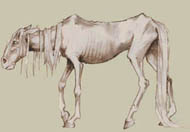 Care
and Feeding Care
and Feeding
Care and feeding of your horse involves grooming and food.
Basic tack, tools for grooming and food are available from
a supply shops. Grooming your horse with a variety of implements:
a curry comb, a stiff or soft brush (you TURN the
brush to swap between the two sides), a mane and tail brush,
and a hoof pick.
To purchase, just:
ASK (shopkeeper) ABOUT [tack|groom|food]
Stable shops sell hay, grain, apples, carrots and salt cubes
for your horse to munch on when he or she gets hungry.
To purchase, just:
ASK (shopkeeper) ABOUT [tack|groom|food]
To feed your horse, just hold the food in your right hand
and:
FEED <food> to HORSE
Grooming Guide
To clean the mane and tail, you type CLEAN HORSE
with empty hands until you are told you need a brush. At that
point, continue to CLEAN the horse with the soft
brush until you are told to use another tool. From there,
you use the mane and tail brush until you're finished.
Then, to clean the coat, hold the curry comb and CLEAN
HORSE again. After you are finished with the curry comb,
take the soft brush and TURN it to use the stiff
side. When that step is completed, you will use the soft brush
again (TURN the stiff brush) to complete this step.
Finally, to clean the hooves, get your hoof pick and type
CLEAN HORSE to clean out one hoof. (Remember, a horse
has four hooves, you have to clean the other three as well!)
Tack, Gear and Barding
Horses may need some equipment before you can just jump on and
ride away.
| Some Items of Tack Available
in Shops |
- Headgear - halters and bridles
- Padding - blankets, quilts, caparisons and saddle
pads (Note: If you want to use
a saddle, you should at least have one layer of padding
under the saddle to protect the horse.)
- Saddle - Saddles range from plain to very fancy.
They can also be worn on your shoulder for easy transport.
(Note: You don't HAVE to purchase
a saddle. While it's possible to ride with just a blanket
or other form of padding, it's also possible to ride bareback,
but that requires special training from a Ranger of sufficient
skill.)
|
Of course, if you want to protect your equine associate from attacks.
| Some Barding Armor Available
in Shops |
- Chanfron - covers the head of the animal
- Crinnet - covers the neck of the animal
- Peytrel - covers the chest area and legs of the
animal
- Crupper - covers the hindquarters and legs of the
animal
- Flanchard - covers the legs and abdomen of the
animal
|
Each of these pieces of barding is currently available in leather,
chain or plate.
Movement:
Horses have four speeds: walk, trot, canter and gallop. Walk moves
your horse at the same speed that your character moves, one room
at a time. Trot, canter, and gallop move two, three and four rooms
at a time, provided that there are enough rooms in a row in that
specific direction. If you gallop north and there are only three
rooms with a northern exit, the horse will travel three rooms north
and then stop to see which way you want to go next.
To make your horse change speed:
SIGNAL HORSE to [walk|trot|canter|gallop]
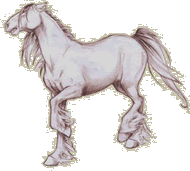 Teaching Your Horse Teaching Your Horse
The Stablemaster can teach you the basics of horsemanship. He also
teaches combat, jousting, and mounting a horse in combat to Paladins.
Loading of ranged weapons while mounted he teaches to both Paladins
and Barbarians.
Stablemen familiar with training horses can teach Rangers the various
"tricks" possible, once the Ranger has had a basic horsemanship
class from the Stablemaster. In turn, the Rangers can teach these
tricks to horses. Tricks include BEG and SPIN. You can also teach
your horse to JUMP over certain things. (Some stables and training
areas have special places set up where you can jump barrels, fences,
and the like.)
To use a trick:
SIGNAL HORSE to [beg|spin]
SIGNAL HORSE to JUMP (thing)
Certain guilds are able to use the INSTRUCT verb to teach
horses and players how to do different things. As always, effectiveness
of lessons to be taught depend on the skill of the teacher and of
the student.
| Lessons Each Guild is
Able to Teach |
|
|
Specific lessons include:
KNEEL - required for allowing shorter races like Halflings,
Gnomes, and Dwarves to mount a horse.
ANIMAL or RACE - teaches horses not to be scared
of certain races like Rakash or Prydaen. If your horse is not trained
to tolerate these races, the horse is likely to bolt when someone
approaches it.
LEADROPE - teaches your horse to allow bridles or halters
to be placed on it.
SADDLE - trains your horse to tolerate a saddle.
(Note: Most horses bought in corrals
will come with LEADROPE and SADDLE already learned,
but some horses, particularly those caught in the wild when that
part of the system is released will not.)
COMBAT - teaches horses to go into combat.
JOUSTING - an advanced course on the jousting skill. The
basics on jousting are included in the horsemanship lecture you
get from the stable master, but the advanced course allows your
horse to perform even better.
MAGIC - teaches your horse to remain calm during the preparation
and casting of offensive spells.
PREPARE - teaches you the proper way of casting of non-combat
spells without spooking your horse while mounted.
Horses may also learn WAR, which allows your horse to
fight along your side in combat. While any horse may learn the skill,
only a Paladin's horse may truly utilize the training.
A skill exclusive to Paladins is MOUNT, which teaches
them how to allow their horse to fight while mounted.
Lessons range from 20 to 180 minutes, real time.
Once your horse has been trained for combat, this leads to...
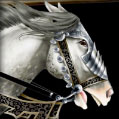 Jousting Jousting
Jousting requires that you have a lance in hand, be mounted on
your horse, and issue a challenge to another mounted character.
To initiate the challenge, you must SIGNAL HORSE TO JOUST <player>
and the other player will automatically be told how to respond.
If they agree, the joust will automatically begin in ten seconds.
Holding a shield and wearing armor (particularly heavy plate) is
recommended while jousting!
You may purchase a blunted lance, but regular lances will work
as well. Be wary, however. There's a strong chance that lances will
be broken and lost during a successful joust.
Some training fields and jousting areas include quintains to facilitate
jousting practice. To use them, just GO QUINTAIN while
mounted on your horse and holding your lance.
Other Forms of Interaction With Your Horse
Currently, you can PET, HUG, TOUCH, KISS, SCRATCH, and
RUB your horse. The APPRAISE and STUDY
verbs are also quite useful in order to make sure your horse is
in good shape, well fed, and properly groomed.
The Future
Future system enhancements will include features like horse trading,
capture and training of wild horses, horse theft, and a whole lot
more!
|



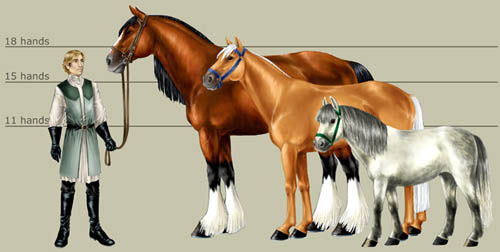
 Care
and Feeding
Care
and Feeding

